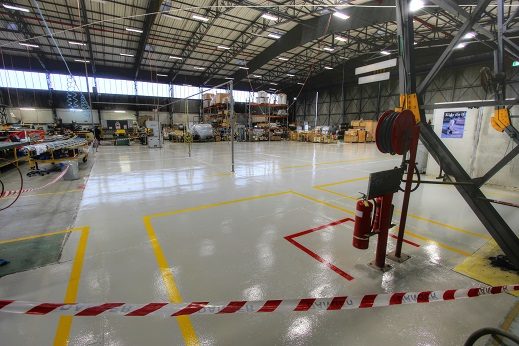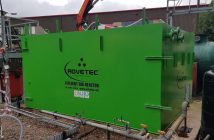Industrial facilities may get larger and production processes faster to cope with increasing global demand, but plant designers still have to adhere to safety standards, regulations and guidelines.
There are challenging conditions and demands on modern business. One very important one is ensuring that the workplace is safe and comfortable for staff and visitors. The floor covering of any workplace is a key component that is increasingly being seen as a vital part of meeting certification requirements.
Some industrial workplaces, such as research laboratories, food processing plants or hospitals, place a range of additional stresses on any flooring used. Flooring may be exposed to corrosive substances such as fats, hot oils, blood, sugar solutions and food acids.
In addition, there may be multiple sources of thermal shock, such as blasts of -25°C air from an open cold storage unit or steam cleaning at 120°C. Rigorous cleaning processes using caustic solutions also place a lot of stress on any floor covering.
Preparing a floor and applying a coating requires a special range of skills and understanding of the physical nature of the material being handled. “It is essential that time is spent at the planning stage to ensure that the customer’s expectations are matched,” says Rhino Linings Australasia (RLA) General Manager Peter Morgan.
For the majority of its flooring projects, RLA produces a range of 100 per cent solids epoxy coatings. “The term ‘100 per cent solids’ means that whatever is put on the floor is what stays there, nothing is lost as solvent,” Morgan explains.
Tough task
The structure of the polymer used for industrial flooring has to be resistant to abrasion and chemical attack. The good mechanical, chemical and heat resistant properties of an epoxy coating are obtained by reacting the linear epoxy resin molecules with suitable curatives to form three-dimensional cross-linked thermoset structures in a process commonly referred to as curing.
In principle, curing can be achieved using any molecule containing a reactive hydrogen that can react with the epoxide groups in the resin. Epoxy can either react with itself (homopolymerisation) or by forming a copolymer with polyfunctional curatives or hardeners. Common classes of hardeners for epoxy resins include amines, acids, acid anhydrides, phenols, alcohols and thiols, all of which have varying relative reactivity.
Some epoxy resin/hardener combinations will cure at ambient temperature but many need to be heated for the most effective curing. Insufficient heat during the curing process will result in a network with incomplete polymerisation, and thus reduced mechanical, chemical and heat resistance.
There are many constraints that have to be considered for a successful floor coating project. It is essential that the floor is clean, dry and free from contaminants. Prior to applying any coating, a floor must be properly prepared which usually means that it should be ‘scarified’ or ‘shot blasted’ to give it the correct profile to ensure optimum adhesion.
While the ideal situation would be to apply a floor coating to the clear, open expanse of a new warehouse, the majority of projects are remedial, where the coating has to be applied around, under or through existing equipment or furniture.
Time saver
Being able to be applied in one application to any thickness, along with the rapid curing properties of the products, dramatically reduces down time normally associated with multi-coat flooring systems. “All our customers want a quick return to service, with no smell and a rapid cure time,” Morgan adds. “This is even more important where food is handled.” Some floor coating materials have a high solvent content, he notes. “This is usually because they are less expensive and easier to spread on the substrate.” Methylmethacrylate is one high solvent coating that is still used by some applicators.
For many years there has been extensive research carried out on water-based coatings. The earliest didn’t have the same strength or durability, but technology and materials have greatly improved the quality and usability of water-based versions.
It is also possible to adapt epoxy floor coatings to also provide a non-slip surface for safety, but this usually involves a compromise because bacteria and other contaminants can be caught in the textured surface of the flooring. Non-slip properties are achieved by incorporating sand/filler to bulk out the epoxy mixture and give it a ‘porridge’ consistency which can be troweled and brushed onto the substrate.
The appearance of the flooring can be made an integral part of the health and safety régime of a workplace. Bright colours can differentiate between various zones and can be used to highlight hazardous areas while glossy tones can make the working environment more pleasant for the staff. For the food and beverage industry, flooring materials must be able to withstand the sector’s fast pace while effectively minimising contamination risks.
Seamless, impervious finishes, such as epoxies, stop contaminants hiding within hard to clean gaps where they can multiply. Durability goes hand-in-hand with this, as the floor will be subjected to many causes of damage that could turn into an unsightly, unsafe and unsanitary surface.
When changing the flooring of an industrial site, another consideration is the cleaning protocols required. The cleansing agents and application methods are very different for traditional tiles and a non-slip, epoxy-based floor coating.
Clearly, then, when it comes down to footfall there’s a lot more to selecting the right floor covering than simply specifying by price alone – whatever the industry or application




